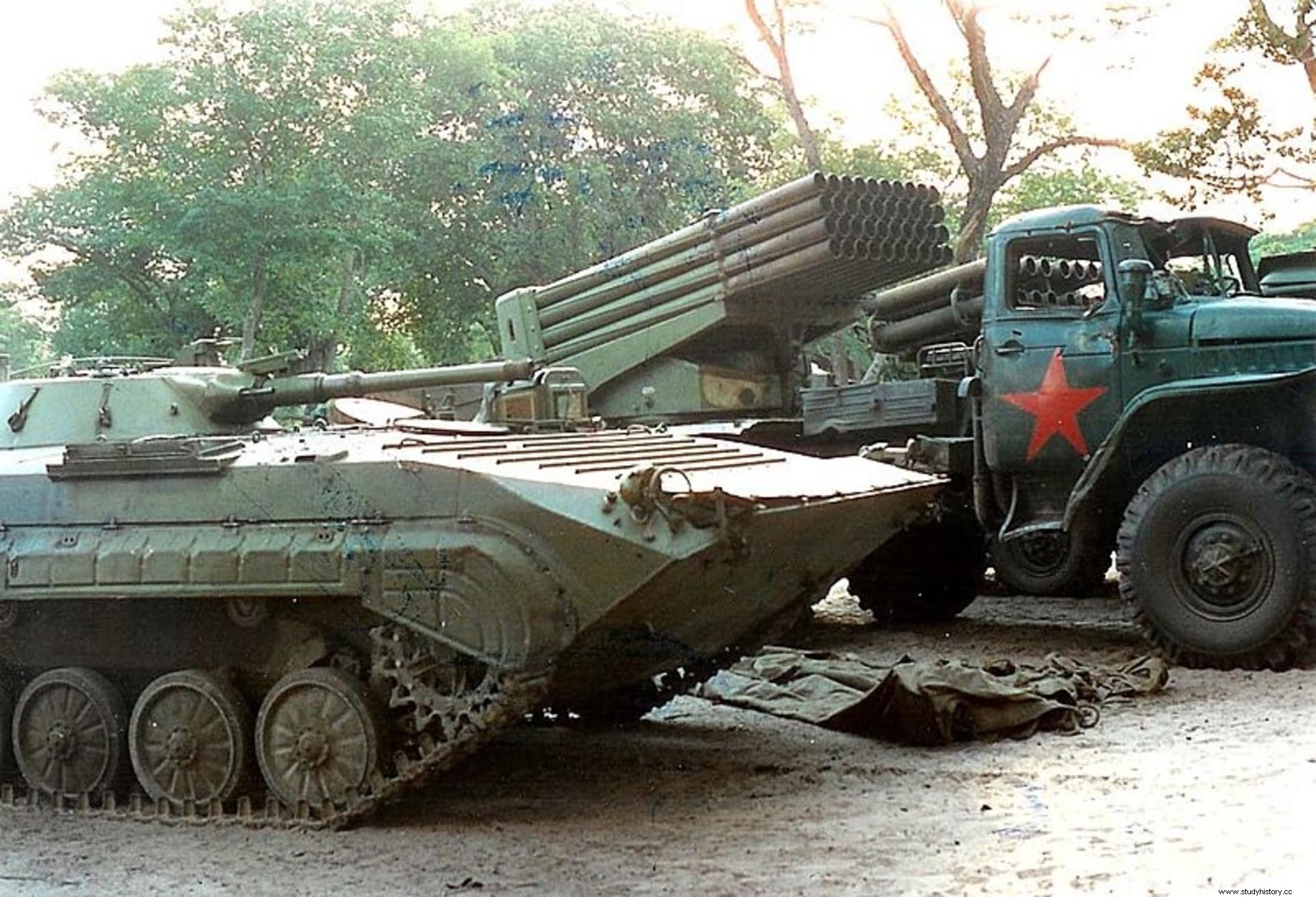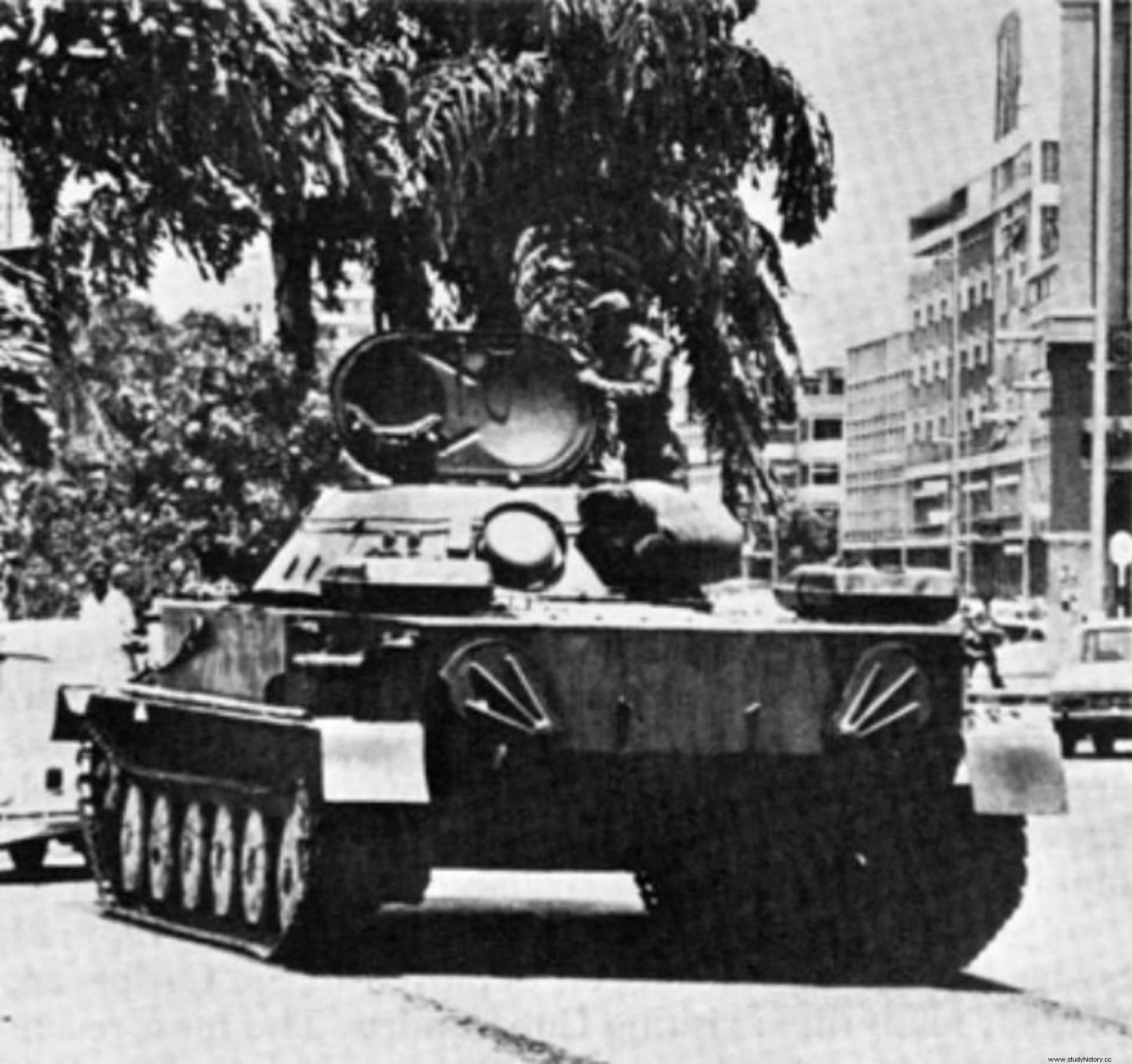
Aggravating anti-colonial fragility, in early 1974 the MPLA had fragmented into three factions:the one based in Tanzania led by Agostinho Neto and two others supported by Zambia and the Congo. The Soviets made efforts to restore the unity of the MPLA and create a liberation front together with the FNLA, but due to little progress, Soviet support dwindled and by March of that year the MPLA had ceased to exist as an effective force.
The fall of the Estado Novo by the Carnation Revolution of 1974 meant that the new revolutionary government put an end to the war by recognizing the independence of the colonies. This made the Kremlin return to work to win over the populations of the Portuguese colonies and in Angola they tried to strengthen the MPLA under the leadership of Neto. But the other factions were not willing to cooperate and in October the USSR changed its strategy . Instead of forcing the unification of the MPLA, they focused on strengthening Neto's supporters. It was a hit. On October 21, a ceasefire was signed between Portugal and the MPLA, the movement regained popular support and occupied important oil enclaves in Cabinda. Meanwhile, the FNLA and UNITA had grown stronger. The former had procured supplies, weapons, and instructors from China and had moved his troops into the northern provinces. The latter had signed a ceasefire with the Portuguese and was recruiting a good number of Angolans, training them at their bases in the east.
Despite the skirmishes that occurred between the MPLA and the FNLA at the end of 1974, various African heads of state managed to convince the three movements to join in the negotiations with Portugal that would culminate on January 15, 1975 in the Alvor Agreement that stipulated that on November 11 the government of Angola would pass into the hands of an Angolan government coalition. In reality, no one took the "coalition government" thing seriously, and the Alvor Agreement was sabotaged by both the Soviet Union and the United States. Worse yet, thedecolonization of the Portuguese empire it was erratic and improvised, with no clear plan on how to transfer power to the guerrillas. In the Angolan case, after a short period of understanding between the three factions, an escalation of violence began that mainly benefited the MPLA, to the point that Portugal's neutrality was questioned during the transfer of power.
By the summer of 1975 the Angolan provisional government had collapsed and, when the Portuguese flag was lowered for the last time over Angola on November 10, the Portuguese High Commissioner transferred power to all Angolans, not a particular faction, adding fuel to the fire. With the disappearance of the Portuguese authority, the way was free for unrestricted foreign intervention . In the past, both the FNLA and UNITA had asked for help to fight against colonial imperialism; now they did it to eradicate the “communist threat” embodied in the MPLA. The latter asked for help to end the "neocolonial challenge" represented by the other factions.
From decolonization to international intervention
The Soviet intervention in Angola in 1975 it suffered from the same problems as Khrushchev's previous African adventures. There was neither a clear plan nor a strategic objective, Brezhnev delegated the African issue to the Party apparatus without a clear person in charge and in the end, a troika formed by the ministers of Foreign Affairs and Defense, the director of the KGB had to take charge of the situation worrying more about political intrigues than carrying out his mission.
Even so, from the end of 1974 Angola became the scene of a rapid expansion of Soviet-Cuban military cooperation . Until the early 1970s, relations between these two countries had been strained due to the “ betrayal” Soviet Union in 1962, when the USSR abandoned the Caribbean country during the Missile Crisis. But in 1974, Castro sent Brezhnev a plan to transport various units of the Cuban army to Angola. Although the premier flatly refused for fear of creating complications in the détente, Cuba managed to deposit its soldiers on Angolan soil and in November 1975 Cuban units were fighting alongside the MPLA. It was the beginning of “Operation Carlota”, an example of something unique during the Cold War:a Third World country projecting its power beyond its neighborhood. After independence, the Cuban military presence in the country would amount to 12,000 soldiers and later up to 36,000, all of them armed with tons of heavy weapons, as well as about a thousand T-34 and T-54 tanks, SAM-7, anti-tank missiles and MiG-21 fighters.

But the Ford administration was not going to let the MPLA seized power. In mid-July, months before independence became effective, he authorized a large-scale covert operation to help the FNLA (long-time CIA-backed) and UNITA. In three months the CIA spent fifty million dollars to train, equip, and transport anti-MPLA troops. During that summer the FNLA had launched limited offensives against the MPLA along the coast and in the north of the country. In July, the MPLA struck back, seized control of Luanda, and advanced on FNLA strongholds in the north. In early August, South African forces crossed Angola's southern border as regular Zairean troops joined the FNLA in the north. By mid-August the MPLA offensives in the north had been thwarted and Neto's forces were fleeing towards Luanda. The arrival of Cuban troops in September and October was not enough to maintain the gains of the MPLA, which continued its retreat in the face of Zairean and FNLA forces in the north and those of UNITA, supported by South Africa, in the south.
Ironically, the MPLA's chances of winning the conflict were saved by the South African invasion October. In response, Moscow decided to support the Cuban operation when the MPLA made its declaration of independence on November 11, by then fighting for its existence just a few kilometers from the capital. During the previous week, large groups of Cuban soldiers began to arrive in Luanda aboard Soviet planes.
The following fortnight saw a rapid advance towards Luanda by a UNITA army led by 6,000 South African regulars. By the end of November they had reconquered all the territory that UNITA had lost to the MPLA in the previous months. But the Cubans stopped their advance by defeating them in two battles south of the Cuanza River. When, after these military setbacks, the US Senate voted, on December 19, in favor of blocking the financing of covert operations in Angola, Pretoria would abandon the conflict by withdrawing to the border.
Towards the end of the Angolan Civil War
By mid-February 1976 most African countries had alreadyrecognized Neto's government and on the 11th of that month the capital of the anti-MPLA forces, Huambo, was captured. By early March the war was practically won. The FNLA had abandoned its military operations and the remaining 2,000 UNITA guerrillas had withdrawn into the bush in the southeast of the country.
The victory in Angola It meant several benefits for the USSR:Cutting the string of setbacks it had been suffering since the collapse of Salvador Allende's regime in Chile two years earlier; overcome tensions with Cuba; increase Soviet influence in Zimbabwe, Mozambique and South Africa and gain support among the non-aligned. It also allowed Operation Carlota to continue for 16 years, giving the Caribbean country wings to intervene in Ethiopia and maintain technical assistance programs and military missions in several African countries.
In contrast, Gerald Ford removed the word "detente" from his vocabulary and the efforts of the USSR to turn Angola into a socialist state they failed, becoming a bottomless pit for the resources of the Soviet Union (five billion dollars in the period 1977-1988). The violence would not end in 1976, since the FNLA was only dissolved in 1989, while UNITA was never really defeated and, thanks to the support of the United States, remained alive until its surrender and conversion into a political party in 2002. For this reason, the Warsaw Pact was forced to deploy a multinational force in Angola permanently.
But perhaps the most important impact of the victory in Angola was the lessons the Politburo believed it had learned.
- The United States could be defeated in local conflicts under certain circumstances:carrying out the necessary logistical operations and controlling the anti-imperialist forces involved in the conflict (just the opposite of Vietnam).
- The Soviet Union could and should rebuild and reform the anti-capitalist groups in the crisis zones, being able to dominate the development of the internal politics of the Third World .
The consequences of this belief would be disastrous for Soviet foreign policy in the last years of the Brezhnev era. Angola took Ethiopia, and Ethiopia took Afghanistan.
Bibliography
- Vladislav M. Zubkov, A Failed Empire. The Soviet Union in the Cold War , Barcelona, Critique, 2008.
- Fernando Andresen Guimarães, The origins of the Angolan Civil War. Foreign Intervention and Domestic Political Conflict , London, Macmillan Press LTD, 2001.
- A. Westad, "Moscow and the Angolan Crisis, 1974-1976:A New Pattern of Intervention," in Cold War International History Project Bulletin , no. 8-9, 1996-1997.
- Patrick Chabal with David Birmingham, Joshua Forrest, Malyn Newitt, Gerhard Seibert, Elisa Silva Andrade, A History of Postcolonial Lusophone Africa , London, C. Hurst &Co., 2002.
- Peter Vanneman, Soviet Strategy in Southern Africa. Gorbachev's Pragmatic Approach , Stanford, Hoover Press, 1990.
- Piero Gleijses, “Moscow’s Proxy? Cuba and Africa”, in Journal of Cold War Studies , VIII (Spring 2006), no. 2.
